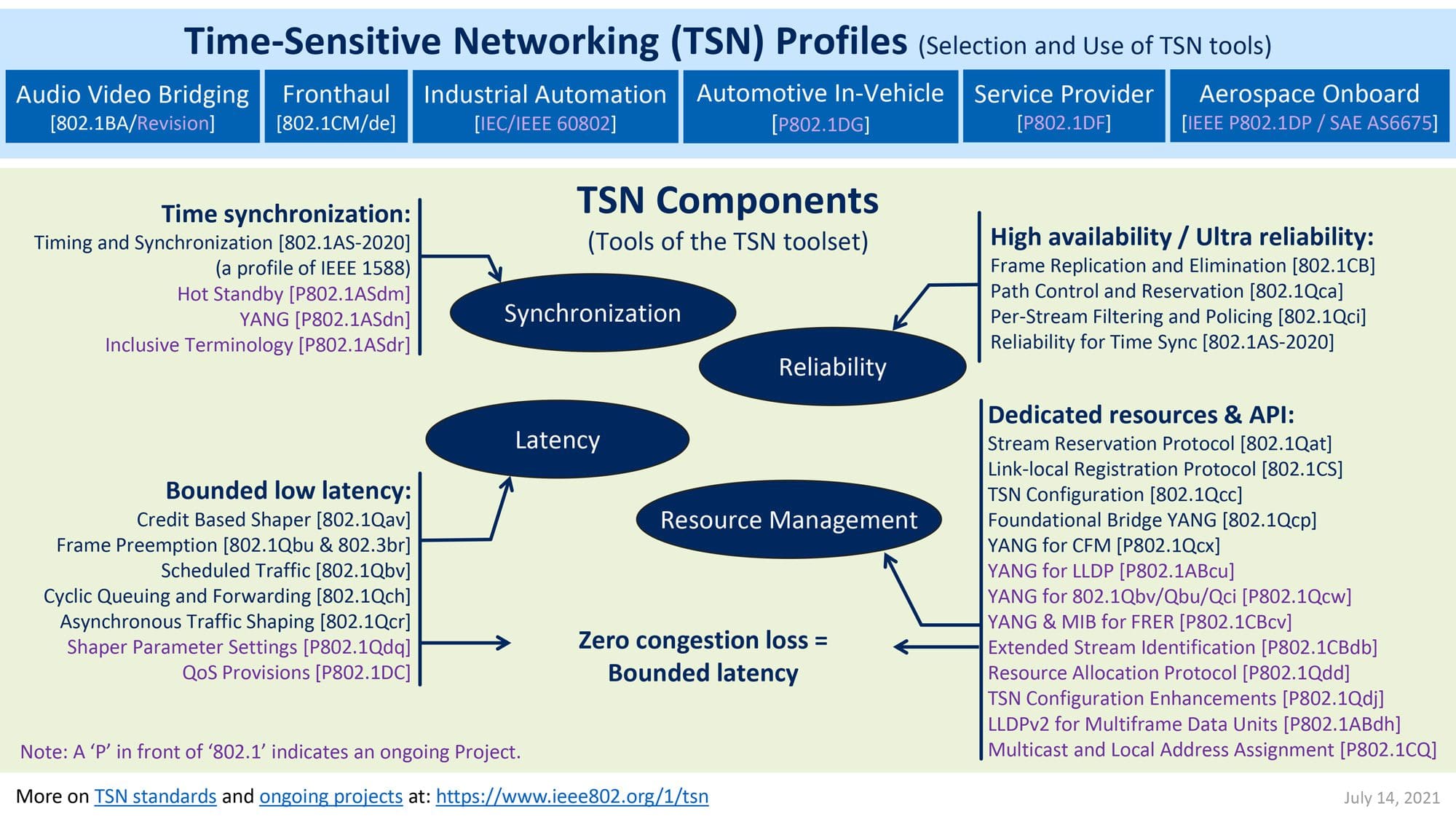Ethernet networking technology has continually evolved to meet increasingly demanding requirements ever since its invention nearly 50 years ago, and its latest enhancement is the ability to perform Time-Sensitive Networking (TSN). TSN will bring real-time monitoring, control, and communications capabilities to autonomous and other connected systems.
Initially used in audio/video systems, TSN is now being implemented in cellular networks and in coming years will be a key enabler for industrial automation/Industry 4.0, Internet of Things (IoT), automotive, aerospace, and other applications.
To define and facilitate widespread adoption of TSN techniques across industries, the IEEE 802.1 Working Group has developed a set of base IEEE 802® TSN standards, colloquially referred to as the “TSN toolset”, for which it won the IEEE Standards Association (IEEE SA) 2020 Emerging Technology Award.
“The IEEE 802.1CM™ and the IEEE 802.1 TSN toolset seamlessly transform xHaul networks enabling operators to dynamically accommodate granular network performance demands required by 5G. As we move “beyond 5G” TSN features and functions will play key role in enabling the required connectivity.”
– Dr Juergen Quittek, an endorser of IEEE 802.1 Working Group for the 2020 IEEE SA Emerging Technology Award; Head of NEC Laboratories Europe GmbH
What is Time-Sensitive Networking and Why is it Important?
Older networking technologies such as synchronous optical networking (SONET) and synchronous digital hierarchy (SDH) were limited to time-division multiplexing (TDM) and individual point-to-point connections, resulting in systems that were highly complex, difficult, costly, and time-consuming to configure and manage. They were also physically substantial, making them a poor fit for use in automotive, aerospace, and other applications where space and weight requirements are key considerations.
Ethernet technology has been a great improvement over these older technologies because as a packet-based networking technology it eliminates hard-wired point-to-point connections, instead sending data from a source to a destination in packets via the best-available path over a network. This offers greatly improved functionality, scalability for bursts of data traffic, better cost/bit and cost of ownership, and fewer physical requirements. However, the inability to ensure that a specific packet will arrive at its destination at a specific time (i.e., the inability to control latency) has limited use in real-time communications.
TSN reduces latency to millisecond or nanosecond levels by incorporating the concept of deterministic data transport, in which the paths data packets travel between given nodes are determined in advance. TSN provides an upper bound on the end-to-end latency, and prevents frame loss due to buffer congestion. If necessary, the transmission of other data traveling on those paths can be preempted at the required times as well.
“I can’t think of a better recipient of this prestigious award than the IEEE 802.1 Working Group. Their foundational work in network timing, namely the Time-Sensitive Networking portfolio of standards, provides a robust synchronization framework that will underpin real-time networking for many years to come.”
– Lowell D. Lamb, Ph.D., an endorser of IEEE 802.1 Working Group for the 2020 IEEE SA Emerging Technology Award; distinguished engineer, Core Switching Group, Broadcom
How is the TSN Toolset Used?
The IEEE 802 standards in the TSN toolset provide various means and options to achieve deterministic data transfer. They not only allow Ethernet bridged networking to be used in applications originally designed with other networking technologies in mind, they will enable entirely new applications as well.
How Does the TSN Toolset Work?
For every vertical, or industry-specific use, a “TSN profile” standard is created. It selects which of the base standards in the TSN toolset to use, and how to use them in that vertical. This work typically requires contributions from the technical community originally involved in the vertical. In turn, the resulting TSN profile becomes a standard that drives progress in the targeted vertical.

It’s not just the TSN standards of the TSN toolset that matter but how they can be used in market-relevant ways once profiled, as well. For fronthaul networking, IEEE 802.1CM provides principles and structure, specifies conformance for devices claiming compliance to the standard, defines how to use the relevant parts of the TSN toolset, and provides deployment and configuration guidance for the use of standard-conformant devices.
802.1CM TSN for Fronthaul: The First Industry Profile to Leverage the TSN Toolset
In 2015, the IEEE 802.1 Working Group started leveraging the TSN toolset with the development of the IEEE 802.1CM™-2018 – Standard for Local and Metropolitan Area Networks – Time-Sensitive Networking for Fronthaul. IEEE 802.1CM specifies the use of TSN in the fronthaul segment of cellular networks.
“Our research shows that eCPRI, network synchronization, and TSN for Fronthaul are among the top 75% of critical technologies in operators’ 5G transport network plans. IEEE 802.1CM recognized the fronthaul challenge early on and moved swiftly to develop the industry’s first standard TSN profile for fronthaul which will accelerate adoption of centralized and cloud RANs.”
– Sterling Perrin, an endorser of IEEE 802.1 Working Group for the 2020 IEEE SA Emerging Technology Award; Sr. Principal Analyst, Heavy Reading.
All mobile voice and data traffic must be transported from the antenna in a radio unit atop a cell tower to the network. In years past, a cable connected the radio unit at the top of the tower to the baseband controller below, via traditional Common Public Radio Interface (CPRI) connections. More recently, telecommunications service providers have used an approach called fronthaul to achieve cost advantages, by pooling radio controllers in a central location to serve antennas on multiple towers. Fronthaul has been deployed as point-to-point fiber because of latency and latency variation (jitter) constraints, as well as the high bandwidth needed.
However, given the proliferation of cellular antennas that will be needed for 5G wireless service, this point-to-point approach will become too expensive and cumbersome. The members of the 802.1 Working Group saw the possibility to migrate fronthaul to an Ethernet packet network instead, given the fact that new eCPRI connections have come into play to improve bandwidth efficiency, increase capabilities, and reduce latencies.
IEEE 802.1CM supports CPRI and eCPRI fronthaul interfaces via an Ethernet bridged network, thereby providing Ethernet-based fronthaul for both 4G and 5G. IEEE 802.1CM offers two solutions to meet the stringent requirements of fronthaul data flows. The mandatory base solution leverages the TSN toolset and aims for simplicity, a key driver in fronthaul networks, while the other solution leverages frame preemption as an additional tool if needed to achieve the required performance.
“Leveraging well known and ubiquitous Ethernet technology, IEEE 802.1CM provides real-time network functions to meet 5G requirements in terms of scale, reliability, flexibility and synchronization, while enabling the delivery of new services at lower cost using standardized packet-based fronthaul technology.”
– James Watt, Vice President & General Manager Optical Networking Division, Nokia, on behalf of predecessor and endorser of IEEE 802.1 Working Group for the 2020 IEEE SA Emerging Technology Award, Sam Bucci.
The TSN toolset is also leveraged in the IEEE 802.1CMde™ amendment to IEEE 802.1CM. IEEE 802.1CMde™-2020 refines the base IEEE 802.1CM profile to provide deterministic Ethernet-based communication among components of the 5G mobile network, and describes how it applies to the F1 fronthaul interface specified by 3GPP.
In development of this standard, the CPRI Cooperation provided the CPRI and eCPRI requirements for fronthaul transport networking. The IEEE 802.1CM project’s feedback helped the CPRI Cooperation advance its own specifications. Gathering these requirements was an important industry contribution as they are now also leveraged by multiple organizations working on fronthaul. For example, IEEE 802.1 interacted and aligned with Question 13 of the ITU’s Telecommunication Standardization Sector (ITU-T) Study Group 15 on synchronization requirements, helping Question 13 advance its own standardization efforts (e.g., ITU-T G.8271.1).
“In my role as Rapporteur, I appreciate the extremely good cooperative spirit with IEEE 802.1. The results of this cooperation are particularly visible in IEEE Std 802.1CM that is a very good example of how different standardization bodies can put together their expertise to evolve technology and standards.”
– Stefano Ruffini, an endorser of IEEE 802.1 Working Group for the 2020 IEEE SA Emerging Technology Award; ITU-T Q13/15 Rapporteur from Ericsson.
IEEE TSN standards development work for fronthaul to date is referenced in the following:
- The provisions of IEEE 802.1CM are referenced in IEEE 1914.3™-2018 – IEEE Standard for Radio over Ethernet Encapsulations and Mappings.
- The synchronization requirements of IEEE 802.1CM are referenced in IEEE 1914.1™-2019 – IEEE Standard for Packet-Based Fronthaul Transport Networks.
- IEEE 802.1CM is referenced by the “Control, User and Synchronization Plane Specification” of the O-RAN Fronthaul Working Group of the O-RAN Alliance.
Laying the Foundation for Other Vertical TSN Profiles
Considering its foundational impact, the TSN toolset is finding additional use in other verticals besides telecommunication networks, and is inspiring work at Layer 3 of the OSI networking model. Considerable work is ongoing on TSN profiles for industrial automation (IEC/IEEE 60802) and automotive in-vehicle Ethernet communications (IEEE P802.1DG), and work recently started on a TSN profile for aerospace onboard Ethernet communications (IEEE P802.1DP / SAE AS 6675).
TSN will provide real-time connectivity and quality of service to time- and mission-critical Industry 4.0 applications. By converging independent information technology applications and operational technology applications such as closed-loop machine control onto a single Ethernet network, the possibility exists to have real-time data communication using the same infrastructure (cables, bridges, etc.) to reduce cost and complexity. TSN meets these requirements by providing interoperability via open standards, leading to the necessary synchronization and real-time communications performance.
The TSN toolset also appeals in automotive and aerospace verticals, in part due to weight reductions allowed by converging to Ethernet, which contribute to lower carbon footprints. TSN toolset derivative work may also provide a basis for further developments, such as conformance and test specifications. The success of the TSN toolset has inspired wireless extensions in development (IEEE P802.11be, IEEE P802.15.6a, 3GPP Release 16 and up, IETF Reliable Available Wireless).
With regard to electric utility smart grid applications, IEEE 802.1 collaborated with the IEEE 802.24 Working Group to develop the Utility Applications of Time-Sensitive Networking white paper in support of potential smart grid applications of the TSN toolset. This work is also leveraged by IEC TR 61850-90-13:2021 – Deterministic Networking in Power Automation. The IETF Deterministic Networking (DetNet) Working Group also produces standards to extend the technology base provided by the TSN toolset to Layer 3 routed segments, thus making the benefits available for larger network segments.
The IEEE 802.1 Working Group was selected in 2020 as a recipient of IEEE SA’s Emerging Technology Award for the development of IEEE 802.1CM as “the first IEEE standard to connect a cellular network’s radio equipment to its remote controller via a packet network, in particular, over a bridged IEEE 802.3™ Ethernet network.”
Learn more about IEEE 802.1 Working Group or purchase the IEEE 802.1CM Standard.
Authors:
- Glenn Parsons, Chair, IEEE 802.1 Working Group
- Jessy Rouyer, Vice Chair, IEEE 802.1 Working Group
- Janos Farkas, Chair, IEEE 802.1 TSN Task Group; Editor, IEEE 802.1CM









